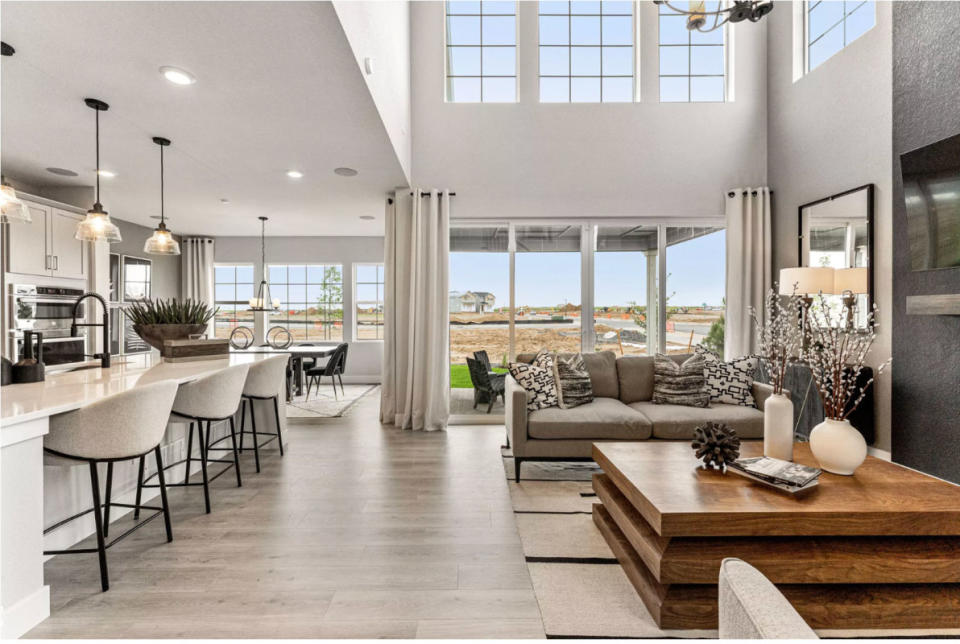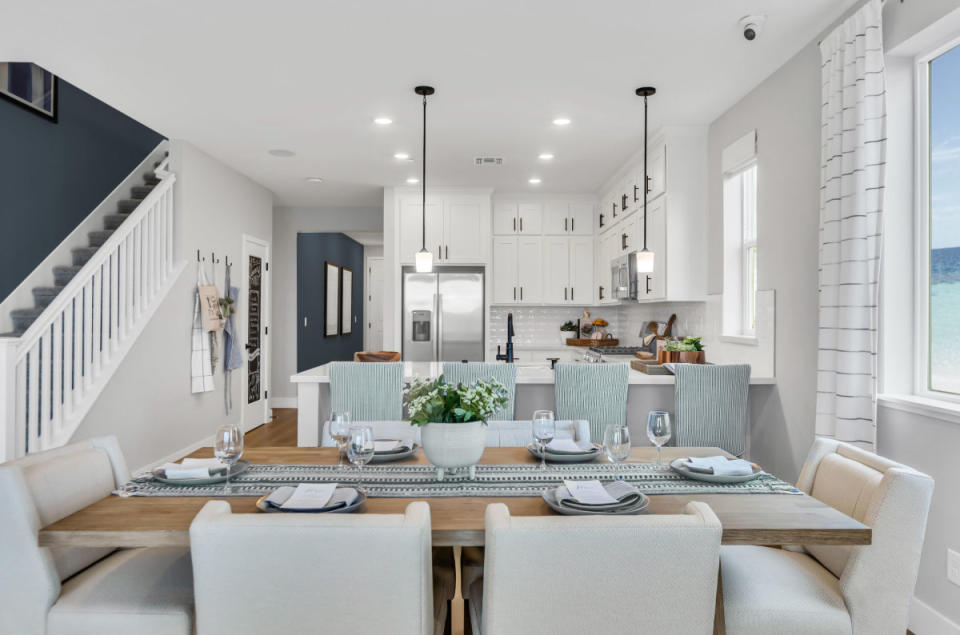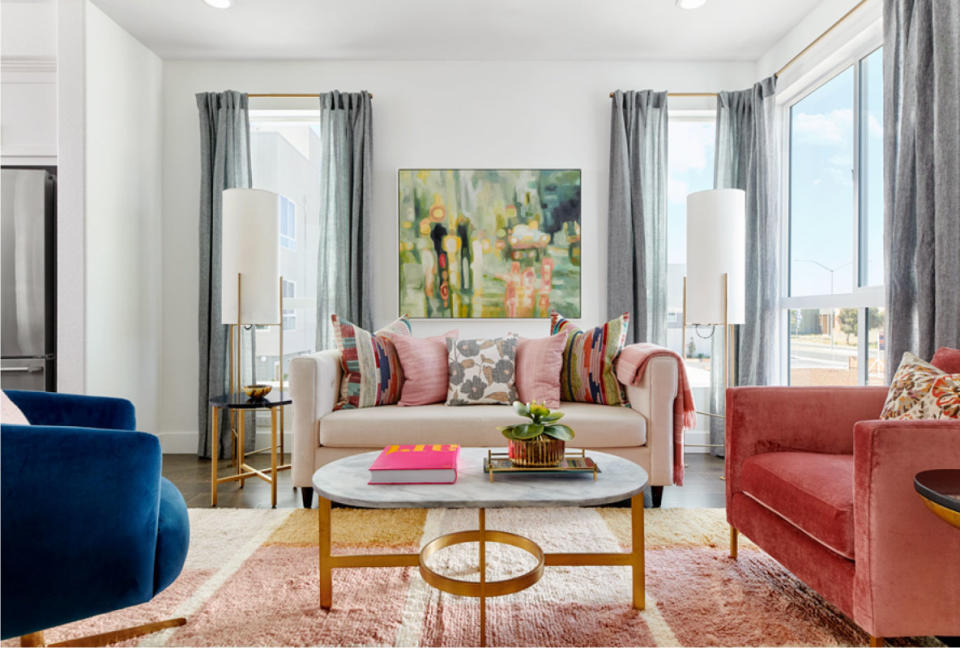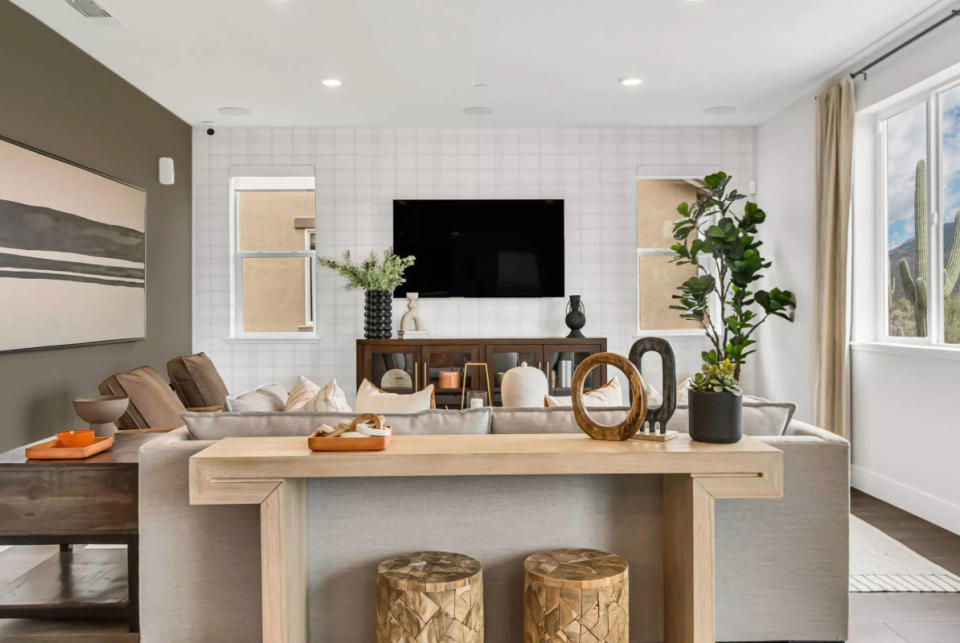5 New Interior Design Trends Sought By the Next Generation of Homeowners
Goodbye, modern farmhouse and ultra minimalism. These five new approaches to interior design are trending with the next generation of homebuyers. "As younger generations near their home-buying years, we're seeking new and creative ways to reach them and begin building brand affinity early on," said Taylor Morrison Chief Marketing and Communications Officer Stephanie McCarty. One way the developers cater to new architectural and design trends is by activating new floor plan elements such as offset alignment of the front and back doors, optimized staircase placement, and front doors that face away from the street. In other ways, they're preparing indoor spaces with architectural elements like plaster details, popular tiles, and a depth of natural materials.
To identify predictions for design elements indoors and out, Taylor Morrison, one of the nation's leading homebuilders and developers leveraged insights from designers and architectural experts and tracked the evolution of interior design by way of hashtags like #aesthetic and #core.
Related: The Biggest Trends for Outdoor Spaces in 2024
![<p>Taylor Morrison</p>Dark Academia<p><strong>"[Think traditional academia,] but with a Gothic twist,"</strong> notes McCarty. Homes channeling academia always embody a cozy and inviting atmosphere, but this approach using dark tones and rich wood finishes helps to further evoke a sense of intellectual comfort and a scholarly ambiance.</p><p><strong>"Gen Z places a strong emphasis on personal expression in their home decor,"</strong> agrees Aino Heinäsuo, Head of Design at <a href="https://www.redecor.com/" rel="nofollow noopener" target="_blank" data-ylk="slk:Redecor;elm:context_link;itc:0;sec:content-canvas" class="link ">Redecor</a>. "They frequently opt for bold colors, unique art pieces, and eclectic styles that showcase their individual tastes and identities. This generation prioritizes creating functional spaces that feel uniquely their own, rather than adhering to traditional design rules. Millennials also appreciate personal expression in their decor but usually seek a perfect blend of it within a cohesive design scheme. They combine personal touches with classic design elements, striving for a balance between individuality and a polished, unified appearance."</p><p>The aesthetic incorporates:</p><ul><li>A rich and moody color palette</li><li>Rich, dark wood tones</li><li>Plush textures and patterns</li><li>Bold statement pieces</li><li>Intricate plaster details evoke a sense of intellectual comfort and a scholarly ambiance</li></ul>](https://s.yimg.com/ny/api/res/1.2/M4HBkv8hCP1S7JAhnOjIjA--/YXBwaWQ9aGlnaGxhbmRlcjt3PTk2MDtoPTYzNA--/https://media.zenfs.com/en/men_s_journal_718/51642169762bd7800e14ce4dadc0a9af)
Taylor Morrison
Dark Academia"[Think traditional academia,] but with a Gothic twist," notes McCarty. Homes channeling academia always embody a cozy and inviting atmosphere, but this approach using dark tones and rich wood finishes helps to further evoke a sense of intellectual comfort and a scholarly ambiance.
"Gen Z places a strong emphasis on personal expression in their home decor," agrees Aino Heinäsuo, Head of Design at Redecor. "They frequently opt for bold colors, unique art pieces, and eclectic styles that showcase their individual tastes and identities. This generation prioritizes creating functional spaces that feel uniquely their own, rather than adhering to traditional design rules. Millennials also appreciate personal expression in their decor but usually seek a perfect blend of it within a cohesive design scheme. They combine personal touches with classic design elements, striving for a balance between individuality and a polished, unified appearance."
The aesthetic incorporates:
- A rich and moody color palette
- Rich, dark wood tones
- Plush textures and patterns
- Bold statement pieces
- Intricate plaster details evoke a sense of intellectual comfort and a scholarly ambiance

Taylor Morrison
Quiet LuxuryLuxury has become more refined as homeowners opt to master the art of subtlety. From floors to walls and furnishings, it avoids the opportunity to create contrast, opting instead of a minimal color palette (maybe with cooler earth tones that suggest a touch of Scandinavia). With accents like these, it's easy to create a space that's luxurious while being anything but neutral:
- Combined textures
- Limited prints
- Classic lighting
- Natural materials and elements
- Rich fabrics

Taylor Morrison
Coastal GrandmaLike most coastal themes, this trending aesthetic captures the feeling of living in an oceanfront escape. Unlike former coastal trends, Coastal Grandma uses more of the floral and botanical prints you might associate with your grandparents' home, while making it modern with refreshing linen upholstery and treatments, contemporary wood and rattan furnishings, and an assortment of colors in muted, earthy tones. In many ways, these are already considered to be vintage, iconic pieces reminiscent of their youth. And yes, you might see a few vintage pieces from Grandma's own collection. 😉

Taylor Morrison
Dopamine DesignWe liken the dopamine design aesthetic to traditional "maximalism," wherein a homeowner uses the space to celebrate self-expression and personal style in home decor. Yes, it's sort of the opposite of quiet luxury, but many buyers are determined to create their own, unique space.
"It's a whimsical and imaginative approach," agrees McCarty. "It encourages homeowners to boldly express their personal tastes and creativity throughout their living spaces." This design style is all about embracing uniqueness and self-indulgence in modern interior design, but that said, for some Gen Zers, there is such a thing as too much. "Only 23% identify as maximalist," notes Heinäsuo, of the recent survey 'Decorating Differently: A Study of Generational Sustainability in Home Design' by Redecor. 11% of Gen Z even said that they find 'cluttercore' to be cringy.

Taylor Morrison
SouthwesternHave you picked up on the emphasis given to natural materials? The Southwestern interior design aesthetic embodies the American West in a spirited way. With an abundance of rustic finishes and desire to create a very, very cozy space, the aesthetic works to celebrate the rugged beauty and culture of the Southwestern United States.
- Rich textures
- Earthy color palette to establish a connection to nature.
- Natural elements and materials
- An overall cozy ambiance
Related: Venus Williams’ ‘Palazzo’ is a New, AI-Powered Interior Design Platform—Try it Now
Is Gen Z into thrifting?
"Gen Z, while being less likely to accept free furniture pieces from friends or the street, often engages in second-hand shopping through curated vintage stores or online platforms," notes Heinäsuo. "They support sustainable brands, but their choices are often influenced by cost considerations and the availability of affordable options. This generation seeks a balance between sustainable design and cost-effectiveness in their decor solutions. [On the other hand,] 50% of Gen X and 45% of Millennials had no problem with upcycled options, according to what participants told our design experts."

